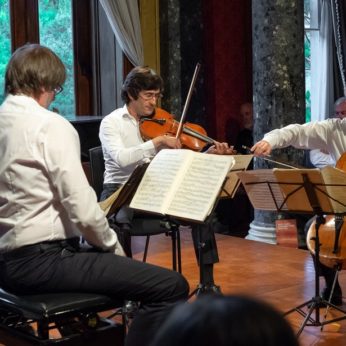Composer: Ludwig van Beethoven (b. 1770 - d. 1827)
Performance date: 29/06/2018
Venue: Bantry Library
Composition Year: 1806
Duration: 00:39:58
Recording Engineer: Tom Norton, RTÉ
Instrumentation: 2vn, va, vc
Instrumentation Category:String Quartet
Artists:
Ella van Poucke -
[cello]
Mairead Hickey -
[violin]
Dudok Quartet Amsterdam Judith van Driel [violin], Marleen Wester [violin], Marie-Louise de Jong [viola], David Faber [cello]) -
[quartet]

Quatuor Danel
Marc Danel, Gilles Millet [violins]
Vlad Bogdanas [viola]
Yovan Markovitch [cello]
Ludwig van Beethoven [1770-1827]
String Quartet No.7 in F Op.59/1 [1806]
1. Allegro
2. Allegretto vivace e sempre scherzando
3. Adagio molto e mesto
4. Thème Russe: Allegro
Nothing certain is known…all posts stopped; every channel of information shut up; we are surrounded by armies on all sides. Report from Vienna in November 1805.
One Austrian army had been destroyed at Ulm and Vienna was occupied by Napoleon’s troops. A few weeks later in the Battle of the Three Emperors, the Russian and Austrian armies were routed at Austerlitz. It was soon after this disaster that Count Razumovsky, the Russian Ambassador at the Emperor’s Court in Vienna, commissioned Beethoven to write three quartets, each containing a Russian theme. At a time when Russian prisoners-of-war, poor miserable ragged wretched objects, were being marched through Vienna, Beethoven was being asked to take sides. The three Op.59 quartets were not only composed in a time of war but are an emphatic declaration of whose side Beethoven was on.
To obtain his Russian themes, Beethoven used a collection of Russian folksongs that had been published in 1790. He borrowed two melodies from this collection, transposing them to suitable keys. For the F major quartet, Beethoven saves the Russian folk-tune for the last movement, and opens the quartet with one of his most memorable themes, which dominates the entire movement with its aura of majestic calm. First heard in the cello, it is passed mid-theme to the first violin and held together with pulsating inner voices of static harmony but suppressed energy. Most of the ideas heard during the exposition, except only the short, lyrical second subject, are derived from this powerful theme. Appropriately the vast development is devoted to it and its associated ideas, the tension never slackening for a moment. And its full-throated return in the recapitulation is prepared with great dramatic flair.
The B flat scherzo is unique with its extended sonata form, no trio and unbridled wit. The opening tapping motif pervades the movement in various guises with its hypnotic rhythm. There is a contrasting second subject group in F minor, but as in the first movement, the development is concerned with the staccato ideas from the opening. The mood changes are bewildering – one minute tender, the next raucously boisterous.
The F minor Largo transports us to that passionate but remote inner world of Beethoven’s, where the ecstatic beauty of the music both calms and inspires us. It was in the sketches for this movement that Beethoven makes his puzzling note about a weeping willow or acacia on the grave of my brother. He began the quartet just after attending his brother Caspar Carl’s wedding, which may have brought back thoughts of his two brothers who died in infancy. Cadenza-like runs lead without a break to the finale with its Russian folk-tune, which was originally a slow, sad tune, but in Beethoven’s hands is cheekily turned into a wild dance, probably to the initial confusion of Count Razumovsky. He would, however, have enjoyed the joke in the coda, when the tune is briefly given at its correct tempo as if to show that the faster tempo is, of course, much more fun.
Francis Humphrys
Copyright © 2025 West Cork Music. All rights reserved.
Designed and developed by Matrix Internet